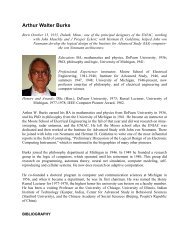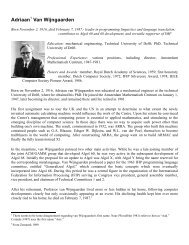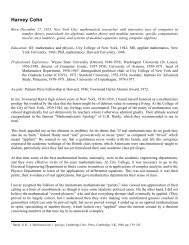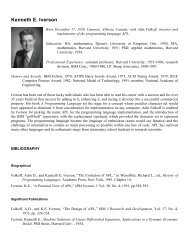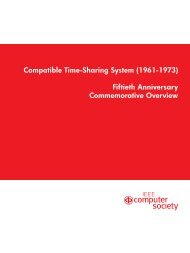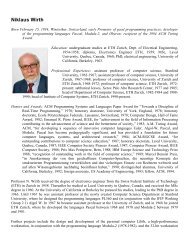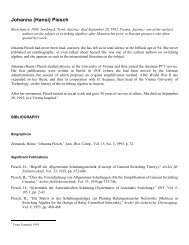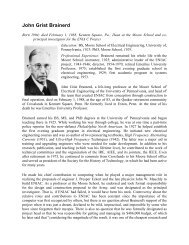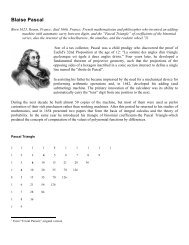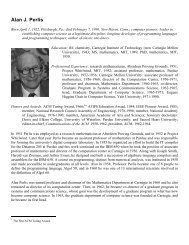John Vincent Atanasoff - Walden Family
John Vincent Atanasoff - Walden Family
John Vincent Atanasoff - Walden Family
Create successful ePaper yourself
Turn your PDF publications into a flip-book with our unique Google optimized e-Paper software.
conference. Mr. Etienne announced his purpose by saying in substance, “If you will help us, we will break the<br />
Mauchly-Eckert computer patent; it was derived from you.”<br />
I hesitated to reply to Mr. Etienne. I was looking back over the years that had passed since Mauchly had told me<br />
(in 1943) that he and Eckert had invented a “new method of computing, different from yours,” and I had<br />
believed him. This was the first substantial item to the contrary that I had encountered. I did not know of the<br />
patent to which Mr. Etienne was referring, that is, the Regenerative Memory patent 2,629,827, issued the<br />
previous year (1953). (The ENIAC patent, applied for in 1947, was not issued until 1964.)<br />
I remember wondering if Etienne was correct.<br />
In 1956, we sold the corporation to Aerojet General Corporation, with principal offices in Azusa, Calif. After<br />
our incorporation into Aerojet General (AGC), we were called the Atlantic Division. In 1959, I was made vice<br />
president of AGC and managed the Atlantic Division.<br />
As the US changed to peace conditions after the Korean War, I used my experience in computing to shift the<br />
activity of the Atlantic Division toward the invention and manufacture of automatic equipment for parcel<br />
handling and sorting. By this time, I had found being a “corporation man” not to my liking. Accordingly, I<br />
resigned as vice president of Aerojet General Corporation early in 1961.<br />
During these years, I was well aware of the growing interest in computing. Even before Mr. Etienne's visit, I<br />
knew that certain companies were making inquiries of anyone skilled in the art, including Dr. Clifford E. Berry<br />
and myself.<br />
From time to time during the twenty-plus years that had elapsed after Berry had left Ames, I visited Clifford and<br />
Jean in their home in Altadena. Nearly every time that my business called me to California, I took an evening to<br />
spend with them and their family. During, say, the first two-thirds of this period, I was told of his interest in and<br />
success with his work, and of his rapid advancement with his company. I do not know exactly when this picture<br />
changed; perhaps by 1960, though, Clifford, while still excited with his work, was less satisfied with the<br />
position he held with his company. I also noticed a slight cynicism in his general attitude, which I took to be a<br />
natural consequence of aging.<br />
Late in 1963, I was overwhelmed to get a letter from Jean Berry, saying that Clifford had resigned his position,<br />
taken a place with a company in Long Island, and had died one night at his apartment.<br />
In late 1967, still feeling unhappy over his death, I made a personal investigation of it. I located his apartment<br />
and talked with the man who had first found him. I also visited the police of the county, since his death was not<br />
natural; he had been found in bed with a plastic sack over his head but with his bedclothes smoothly over his<br />
arms, which were by his sides. An autopsy revealed that his brain plasma had 0.12% alcohol content, which<br />
would have permitted him to drive a car in some jurisdictions. He had been taking Dilantin because of recent<br />
epilepsy, and so his blood and brain were carefully examined for this and other drugs; none was found. Suicide,<br />
said the authorities.<br />
Preliminaries of Litigation






